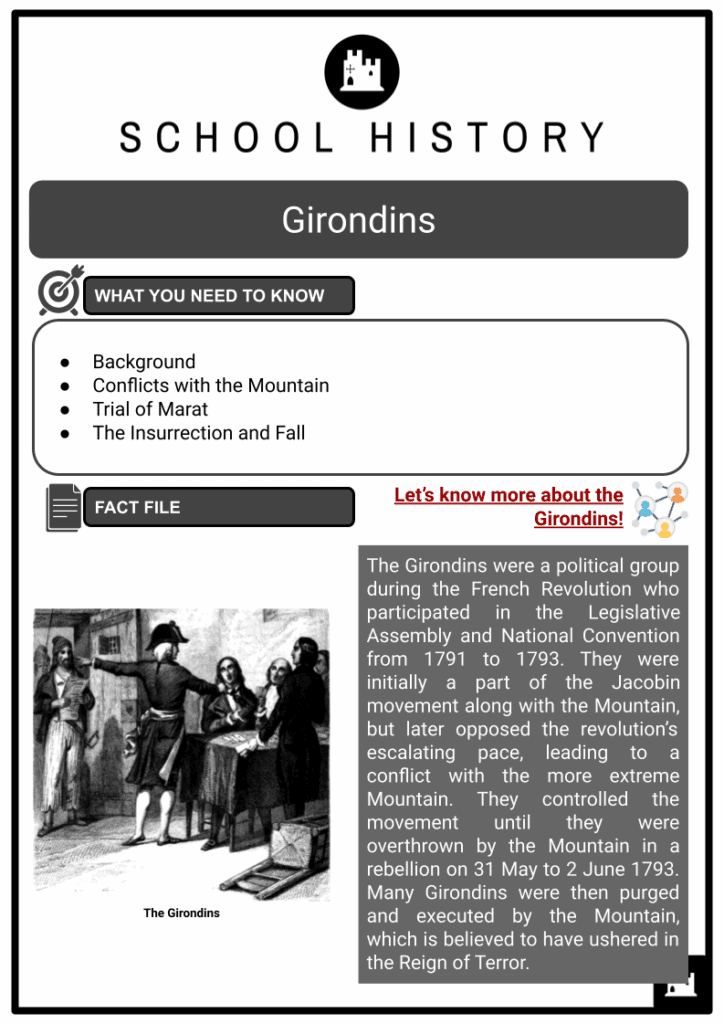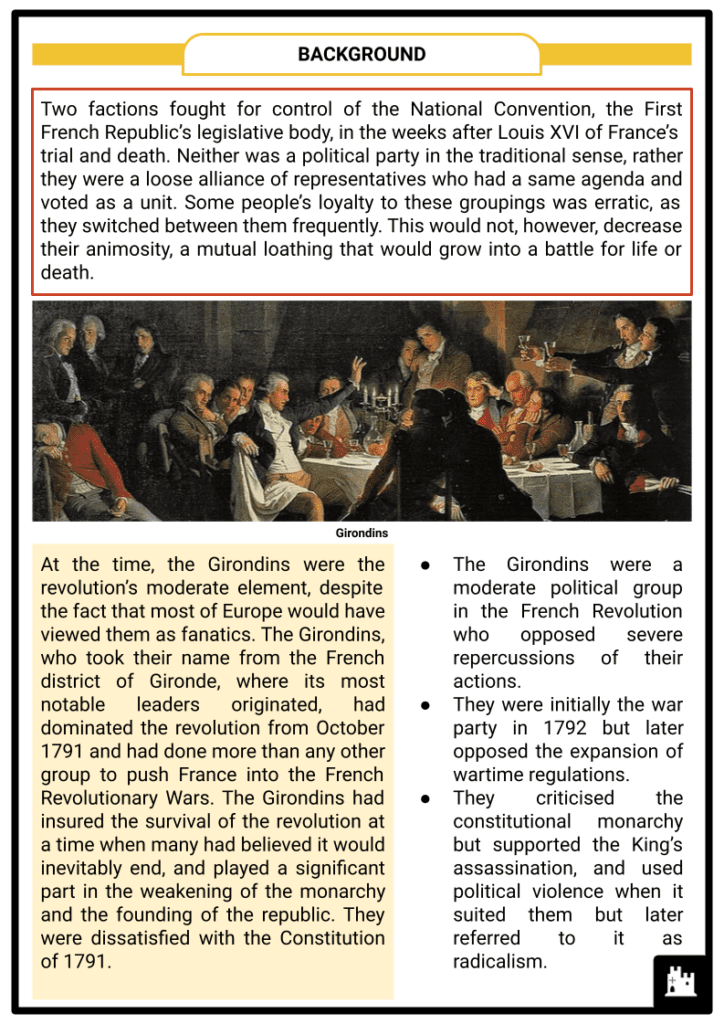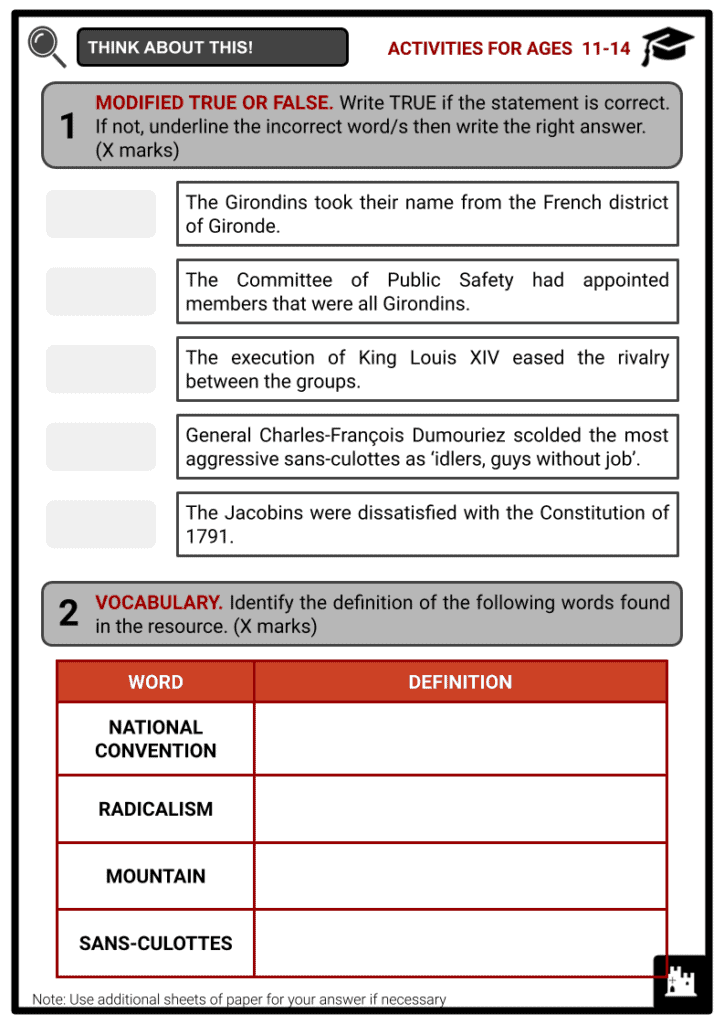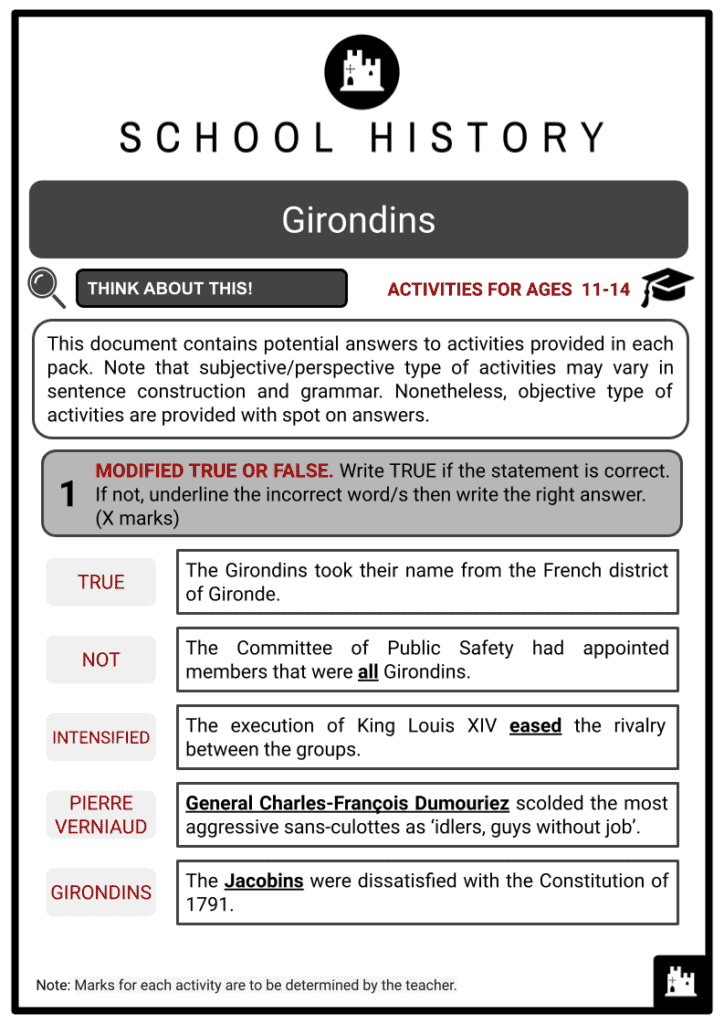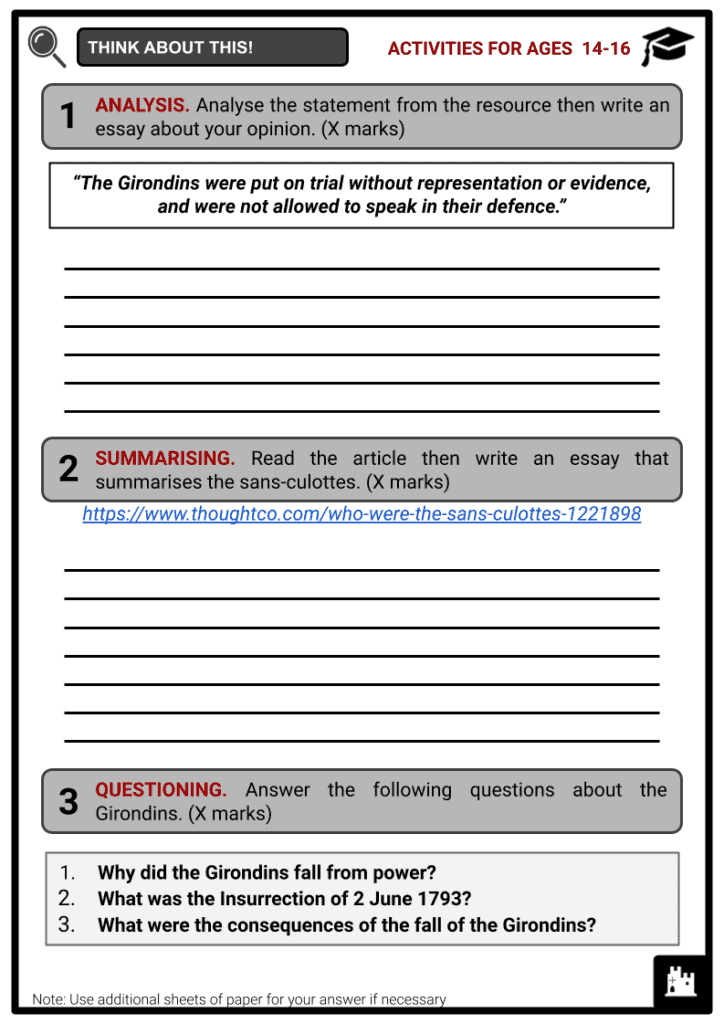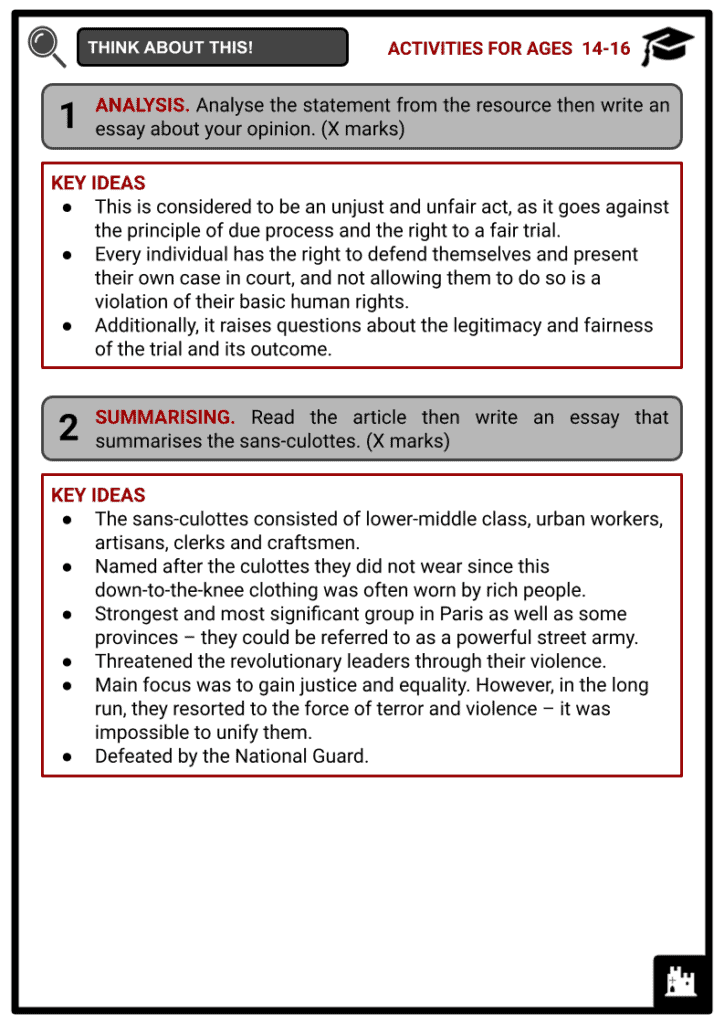Girondins Worksheets
Do you want to save dozens of hours in time? Get your evenings and weekends back? Be able to teach about the Girondins to your students?
Our worksheet bundle includes a fact file and printable worksheets and student activities. Perfect for both the classroom and homeschooling!
Summary
- Background
- Conflicts with the Mountain
- Trial of Marat
- The Insurrection and Fall
Key Facts And Information
Let’s know more about the Girondins!
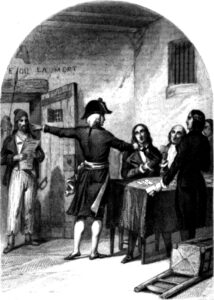
The Girondins were a political group during the French Revolution who participated in the Legislative Assembly and National Convention from 1791 to 1793. They were initially a part of the Jacobin movement along with the Mountain, but later opposed the revolution’s escalating pace, leading to a conflict with the more extreme Mountain. They controlled the movement until they were overthrown by the Mountain in a rebellion on 31 May to 2 June 1793. Many Girondins were then purged and executed by the Mountain, which is believed to have ushered in the Reign of Terror.
BACKGROUND
- Two factions fought for control of the National Convention, the First French Republic’s legislative body, in the weeks after Louis XVI of France’s trial and death. Neither was a political party in the traditional sense, rather they were a loose alliance of representatives who had a same agenda and voted as a unit. Some people’s loyalty to these groupings was erratic, as they switched between them frequently. This would not, however, decrease their animosity, a mutual loathing that would grow into a battle for life or death.
- At the time, the Girondins were the revolution’s moderate element, despite the fact that most of Europe would have viewed them as fanatics. The Girondins, who took their name from the French district of Gironde, where its most notable leaders originated, had dominated the revolution from October 1791 and had done more than any other group to push France into the French Revolutionary Wars. The Girondins had insured the survival of the revolution at a time when many had believed it would inevitably end, and played a significant part in the weakening of the monarchy and the founding of the republic. They were dissatisfied with the Constitution of 1791.
- The Girondins were a moderate political group in the French Revolution who opposed severe repercussions of their actions.
- They were initially the war party in 1792 but later opposed the expansion of wartime regulations.
- They criticised the constitutional monarchy but supported the King’s assassination, and used political violence when it suited them but later referred to it as radicalism.
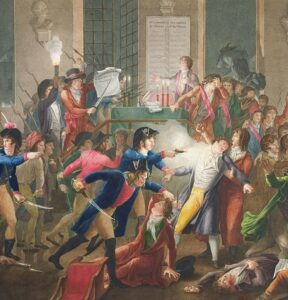
The Mountain - They called for an end to the revolution before it grew too radical in February 1793 and were joined by the French departments in their support of a free market.
- Notable members included Jacques-Pierre Brissot, Pierre Vergniaud, Marguerite-Élie Guadet, Jean-Marie Roland and Madame Roland.
- The Mountain was an extreme communist organisation that controlled the Jacobin Club and opposed the Girondins. Known for their populist ideas catering to the needs of Paris’s working class, their nickname came from their tendency to sit at the front during Convention sessions. The Mountain represented the marginalised of Paris and believed that what was best for the city’s urban poor was best for all of France. The group emerged in opposition to the Girondins in late 1792 and was split into several extremist groups led by Maximilien Robespierre, Georges Danton, Jean-Paul Marat and Jacques-René Hébert.
- The Parisian lower classes had the power over both the Girondins and the Mountain. They were divided into 48 sections and had mostly avoided conflict in the early years of the revolution by allowing their representatives to make policies. However, by 1793 their circumstances had not improved much and they were frustrated by high levels of unemployment, inflation and hunger. They were also fearful of threats from France’s wartime enemies. Calling themselves sans-culottes, they played a vital role in the monarchy’s overthrow and were at the centre of calls for the King’s head. Although the Mountain claimed to speak for them, the sans-culottes were not afraid to take matters into their own hands and watched the revolution closely, ready for the next moment of insurrection.
CONFLICTS WITH THE MOUNTAIN
- King Louis XVI of France was the subject of a dispute between the Girondins and the Mountain. The Girondins wanted to keep him locked up as a valuable political pawn while the Mountain, with the support of the sans-culottes, wanted him executed. They believed that the monarch could not be pardoned and that his execution was necessary to preserve the republic. Louis XVI was put on trial, but ultimately given the death penalty by guillotine. His execution on 21 January 1793 intensified the rivalry between the groups and sparked a power struggle that led to the Reign of Terror.
- In February, the sans-culottes broke into supermarkets in search of commodities, leading to a major fight over le maximum, or set price for bread, in the Convention.
- The Girondins opposed it, saying it interfered with the free market and farmers’ rights to establish prices, while the Mountain supported it.
- The ultra-radicals, known as the Enragés, labelled the Girondins enemies of the people, inciting a mob to attack Girondin-owned print shops and destroy their presses in March.
- The Mountain was able to enforce the ‘law of the maximum’ on 4 May, putting a price cap on wheat and grain, due to this orchestrated political violence.
- The Girondins said that the Jacobins saw any opinions that differed from their own as being equivalent to treason, and cited this attack as evidence that Paris’s sans-culottes had too much power over a revolution that touched the entire nation. The Girondins recommended that the Convention be dissolved and a new assembly be convened in the central French city of Bourges. The Mountaineers fiercely opposed this since it would strip them of their source of power. The Mountain used the recent treachery of General Charles-François Dumouriez, a Girondist ally who deserted to the Austrians following his defeat at the Battle of Neerwinden, to discredit the Girondins by accusing them of preparing military rule.
- In a stirring speech delivered on 13 March, renowned Girondin Pierre Vergniaud criticised the Mountain for encouraging mob violence and compared the burning of the Library of Alexandria to the destruction of the Girondist printing mills. He scolded the most aggressive sans-culottes as ‘idlers, guys without job’, and ‘ignoramuses’ who were infatuated with the sounds of their own voices, citing the threats posed by the chaotic masses of Paris to the continued existence of democracy.
- The Mountaineers present naturally interrupted Vergniaud’s remarks with loud jeers. However, despite the fact that his speech itself was partisan, it addressed the growing factionalism that threatened to undermine the revolution’s remaining vestiges of legitimacy.
TRIAL OF MARAT
- In early April, the Convention made three crucial choices that impacted the Girondin-Mountaineer struggle. On 1 April, a decree repealed the immunity from prosecution of lawmakers. On 5 April, the Revolutionary Tribunal’s jurisdiction was expanded to include anyone reported to a public authority. On 6 April, the Convention formed the Committee of Public Safety, a central body with nine deputy members to supervise government operations. The Committee included seats for Danton and Mountaineer allies, but no Girondins were appointed.
- The three decrees set in motion the final clash between the factions. The Girondins viewed it as a personal attack and responded by attempting to arrest a top Jacobin leader. On 5 April, the Mountain sent a circular to all Jacobin clubs calling for the expulsion of any member who spoke against the execution of Louis XVI. This led to the Girondins targeting Jean-Paul Marat, a belligerent journalist who had just been elected president of the Jacobins and signed the circular. Many Girondins also held personal grudges against Marat due to his crude taunts during debates.
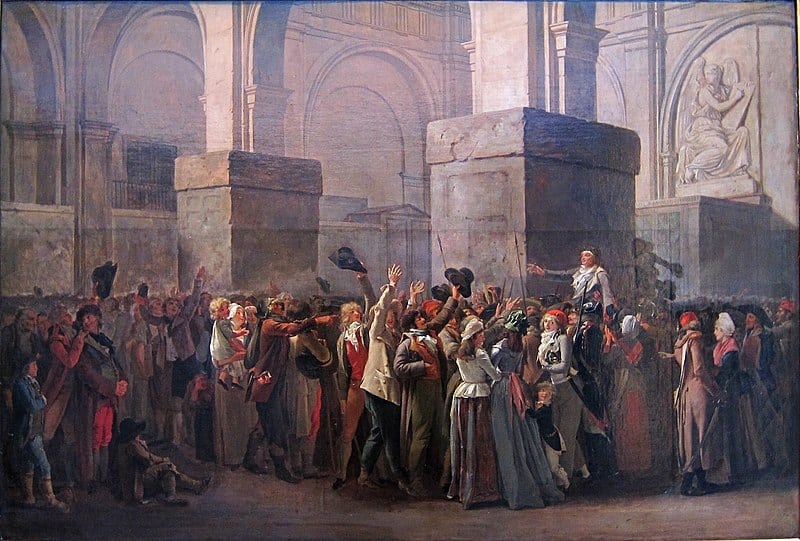
Triumph of Marat - The Girondins attacked in mid-April, while numerous Mountaineers were away from Paris on a mission. They enacted a 19-page indictment against Marat, accusing him of encouraging unlawful violence in his numerous pamphlets and publications, making use of their momentary majority. However, this would quickly backfire. The Girondins learnt of Marat’s enormous popularity after his incarceration when hordes of admirers visited him in jail.
- On 24 April, the day of his trial, the courtroom was jam-packed with onlookers who noisily applauded Marat’s entrance and wouldn’t stop until Marat himself requested them to calm down so he could present his defence. He passionately argued his case, insisting that the comments the Girondins had used against him were misinterpreted. Fortunately for Marat, the judge had Mountaineer sympathies, and he was found not guilty, much to the delight of the throng, who lifted him over their shoulders and showered him with laurels.
- Public opinion against the Girondins changed after Marat’s trial and the implementation of the law of the maximum.
- The Enragés, led by Jean Varlet and Jacques Roux, called for the arrest of 22 Girondin leaders considered enemies of the people.
- Marguerite-Élie Guadet, the leader of the Girondins, announced in mid-May that a Commission of Twelve had been established to plan the overthrow of the National Convention.
- Varlet and Jacques-René Hébert were among the famous members of the Paris sections who were arrested by the Commission, which was mostly made up of Girondins.
- Maximin Isnard warned the Commune to respect the Convention’s decisions in response to their protests. He also warned that if the Commune attempted to incite an uprising, the French departments would rise up and march on Paris, destroying it so much that one would have to look for evidence of its existence along the banks of the Seine.
- Parisians believed in a Girondin conspiracy due to Isnard’s cold statement. It did not intimidate them. Instead, it emboldened the sans-culottes to rebel. When Robespierre gave a speech in the Jacobin Club calling for a ‘moral uprising’ against the dishonest lawmakers, he endorsed this action. The sans-culottes accused 22 prominent Girondins, including Brissot, Vergniaud and Guadet, of committing a crime against the sovereign people at his behest. In response, the Girondins published a circular accusing the Mountain of inciting class conflict. However, despite all the accusations, the Girondins’ feared revolt began on 31 May.
THE INSURRECTION AND FALL
- Thirty-three of Paris’s most extreme groups marched towards the Hôtel de Ville, the headquarters of the municipal administration, escorted by armed National Guard soldiers. The National Guard’s commander, François Hanriot, a former clerk, oversaw the armed sans-culottes as they put forth a list of demands, which included the following:
- the imprisonment of the whole Committee of Twelve, together with the 22 Girondins
- the assembly of a sans-culotte army to defend revolutionary changes
- that three sous per pound of bread be the set price
- that the vote be temporarily restricted to sans-culottes
- After receiving the support of the Paris Commune, the sans-culottes decided to address the National Convention directly. On 2 June, the tocsin in Paris called for the sans-culottes to come to duty. Over 80,000 armed Parisians encircled the Tuileries Palace, where the Convention was taking place, with the help of Hanriot and the National Guard.
- Despite having advance notice of the uprising, the Girondins chose to stay in the city and found themselves confined within the Convention, under attack by the sans-culottes and forced to listen to Robespierre’s denunciation of them. Vergniaud interrupted Robespierre’s speech and Robespierre retorted that he would conclude the speech against him.
- After Robespierre’s speech, the Convention debated what to do with the sans-culottes outside their doors. According to Bertrand Barère, one of the deputies of the new Committee of Public Safety, the targeted Girondins were asked to resign from the Convention in an attempt to ease tensions. Both the Girondins and the sans-culottes found this unacceptable and called for their immediate arrests. At some point, Hérault de Séchelles, the Convention’s president, became impatient and refused to be intimidated by the mob. He ordered deputies to meet with Hanriot and ordered him to stop the act.
- The National Convention lawmakers were in a tense silence, broken by Georges Couthon who declared that the people’s will had been made clear and it was the Convention’s duty to follow it, giving the impression that they had a choice.
- 29 deputies, including 10 members of the Committee of Twelve, were read out by the speaker and arrested. Vergniaud mockingly offered the Convention a drink of blood.
- The Girondins were arrested and remained under house arrest for the rest of the summer and autumn. Some of them fled to incite uprisings in other departments, where Jacobin governments had previously been overthrown in Marseille, Lyon and Bordeaux.
- Other senior Girondins were under protection in Paris until their trial on 26 October.
- The Jacobins were in control and the Reign of Terror was underway, so there was no need for a formal trial as the outcome was already known.
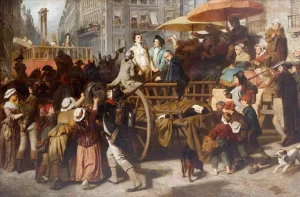
Last Moment of the Girondins - The Girondins were put on trial without representation or evidence, and were not allowed to speak in their defence. They were found guilty and 21 of them, including Brissot and Vergniaud, were executed the next day. The Girondins’ impact was far from over as Federalist Revolts spread throughout France in their name and Marat was murdered by Charlotte Corday using the Girondins’ demise as justification. The Jacobins were in complete control of the revolution when the Girondins were eliminated, but this would not last. The Mountain would eventually split into factions and turn on each other, accusing each other of being anti-revolutionary and executing their former allies. The Terror would continue until Robespierre, Hanriot, Couthon and their associates were executed on 28 July 1794, ending the Reign of Terror.
Image Sources
- https://en.wikipedia.org/wiki/Girondins#/media/File:GirondistsForce.jpg
- https://en.wikipedia.org/wiki/The_Mountain#/media/File:The_arrest_of_Robespierre_cropped.jpg
- https://www.worldhistory.org/uploads/images/16528.jpg?v=1665411025
- https://www.worldhistory.org/img/r/p/500x600/16529.jpg.webp?v=1665411231

